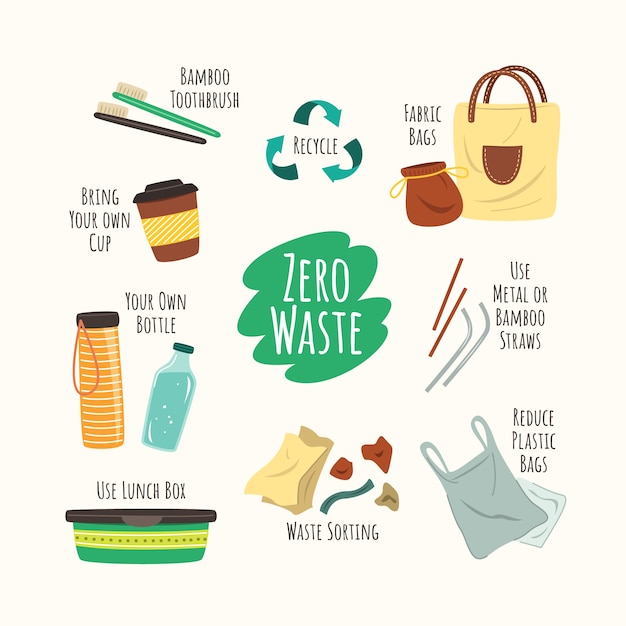Introduction
In an era of rapid industrialization and climate change, sustainable living has become more important than ever. Environmental issues such as global warming, deforestation, and plastic pollution highlight the urgent need for individuals to adopt eco-friendly habits. Sustainable living involves making conscious choices to reduce waste, conserve energy, and minimize one’s carbon footprint.

Understanding Sustainable Living
Sustainable living refers to a lifestyle that reduces an individual’s environmental impact by making mindful choices in energy use, transportation, diet, and consumption patterns (United Nations Environment Programme, 2021). The goal is to balance human needs with environmental preservation so that future generations can also thrive.
The United Nations Sustainable Development Goals (SDGs) emphasize sustainability across various sectors, including clean energy, responsible consumption, climate action, and biodiversity conservation (United Nations, 2015). By adopting sustainable practices, individuals play a crucial role in addressing climate change and conserving natural resources.

1. Energy Conservation
Reducing energy consumption is one of the most effective ways to live sustainably. The energy sector is the largest contributor to greenhouse gas emissions, accounting for approximately 73% of global emissions (Ritchie & Roser, 2020). Implementing energy-saving practices can significantly reduce carbon footprints-
- Switching to Renewable Energy- Utilizing solar, wind, or hydroelectric power reduces dependence on fossil fuels. Governments worldwide offer incentives for installing solar panels.
- Using Energy-Efficient Appliances- Energy Star-rated appliances consume up to 50% less energy compared to traditional models (U.S. Department of Energy, 2022).
- Adopting Energy-Saving Habits- Simple actions such as turning off lights, unplugging devices, and using LED bulbs can lower electricity consumption.
Read More- LA Wildfires
2. Sustainable Transportation
The transportation sector is responsible for nearly 25% of global carbon dioxide emissions (International Energy Agency, 2021). Adopting sustainable travel habits can help mitigate these emissions-
- Public Transportation & Carpooling- Reducing the number of vehicles on the road decreases fuel consumption and traffic congestion.
- Cycling & Walking- Active transportation not only lowers emissions but also promotes physical health.
- Electric & Hybrid Vehicles- These vehicles produce fewer emissions than traditional gasoline-powered cars and contribute to cleaner air quality.
3. Waste Reduction
Waste management is a major global challenge. According to the World Bank (2018), humans generate approximately 2.01 billion tons of solid waste annually. Adopting the 3Rs—Reduce, Reuse, and Recycle—can significantly minimize waste production-

- Recycling & Composting- Properly separating recyclables and composting organic waste reduces landfill overflow and greenhouse gas emissions.
- Minimizing Single-Use Plastics- Plastic pollution is a significant environmental threat, with millions of tons ending up in oceans each year (Jambeck et al., 2015). Using reusable bags, bottles, and containers helps reduce plastic waste.
- Upcycling & Repurposing- Transforming old or unused items into new products reduces the demand for raw materials and promotes a circular economy.
4. Conscious Consumption & Ethical Shopping
Consumer habits have a profound impact on the environment. Fast fashion, overproduction, and deforestation-driven industries contribute to resource depletion. Sustainable consumption practices include-

- Supporting Ethical Brands- Many companies prioritize sustainable sourcing, fair wages, and eco-friendly production. Looking for certifications like Fair Trade and B Corp can help identify responsible brands (Sustainable Brands, 2022).
- Buying Local & Seasonal Products- Locally sourced goods reduce transportation-related emissions and support community economies.
- Embracing Minimalism- Owning fewer, high-quality items reduces waste and promotes mindful consumption.
5. Water Conservation
Water is a finite resource, yet global water demand is expected to exceed supply by 40% by 2030 (World Resources Institute, 2019). Individuals can contribute to water conservation through-
- Fixing Leaks & Using Low-Flow Fixtures- A single dripping faucet can waste over 3,000 gallons of water per year (EPA, 2021).
- Reducing Water Waste in Daily Activities- Shorter showers, efficient dishwashing, and using rainwater for irrigation help conserve water.
- Choosing Sustainable Agriculture Practices- Reducing meat consumption and supporting water-efficient farming methods lowers water usage in food production.
6. Sustainable Food Choices
The global food system accounts for nearly 26% of total greenhouse gas emissions (Poore & Nemecek, 2018). Sustainable dietary choices include-
- Reducing Meat Consumption- The livestock industry is a leading cause of deforestation and methane emissions. Adopting a plant-based or flexitarian diet can lower environmental impact.
- Growing Your Own Food- Home gardening reduces reliance on industrial agriculture and ensures access to fresh, organic produce.
- Avoiding Food Waste- Nearly one-third of all food produced is wasted (FAO, 2019). Meal planning, proper storage, and repurposing leftovers can help reduce waste.
7. Green Building & Eco-Friendly Homes
Sustainable architecture and home designs play a crucial role in reducing energy consumption. Key features include-
- Passive Solar Design- Utilizing natural sunlight for heating and lighting reduces energy needs.
- Green Roofs & Insulation- These features enhance energy efficiency and improve indoor air quality.
- Sustainable Materials- Using reclaimed wood, bamboo, and recycled materials minimizes environmental impact.
8. Community Engagement & Advocacy
Sustainability extends beyond individual efforts—community involvement is essential. Ways to promote sustainability include-
- Joining Environmental Organizations- Participating in tree planting, clean-up drives, and conservation projects creates a broader impact.
- Advocating for Green Policies- Supporting local, national, and global sustainability policies influences systemic change.
- Educating Others- Sharing knowledge on sustainability encourages collective action.
Conclusion
Sustainable living is not about perfection but about making conscious, incremental changes that collectively lead to a significant impact. By adopting energy-efficient habits, reducing waste, making mindful food and consumer choices, and engaging in community initiatives, individuals can contribute to a more sustainable future. Every small action—whether switching to LED lights, reducing plastic use, or advocating for green policies—plays a role in creating a healthier planet for future generations.
References
EPA. (2021). WaterSense: Fix a Leak Week. Retrieved from https://www.epa.gov/watersense/fix-leak-week
FAO. (2019). The State of Food and Agriculture: Moving Forward on Food Loss and Waste Reduction. Rome: Food and Agriculture Organization.
International Energy Agency. (2021). Global Energy Review: CO2 Emissions in 2021. Paris: IEA.
Jambeck, J. R., et al. (2015). Plastic waste inputs from land into the ocean. Science, 347(6223), 768-771.
Poore, J., & Nemecek, T. (2018). Reducing food’s environmental impacts through producers and consumers. Science, 360(6392), 987-992.
Ritchie, H., & Roser, M. (2020). CO₂ and Greenhouse Gas Emissions. Our World in Data.
United Nations. (2015). Sustainable Development Goals. Retrieved from https://sdgs.un.org/goals
United Nations Environment Programme. (2021). Sustainable Living: Guide to Eco-Friendly Choices.
U.S. Department of Energy. (2022). Energy Star Products. Retrieved from https://www.energystar.gov
World Bank. (2018). What a Waste 2.0: A Global Snapshot of Solid Waste Management.
World Resources Institute. (2019). Water Stress by Country.
Subscribe to PsychUniverse
Get the latest updates and insights.
Join 2,984 other subscribers!
Niwlikar, B. A. (2025, January 17). 8 Important Ways for Sustainable Living. PsychUniverse. https://psychuniverse.com/sustainable-living/




Pingback: 5 Psychological Barriers to Sustainability and 4 Ways to Promote It - PsychUniverse